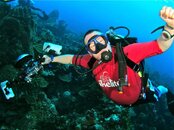JE wrote
Hmmmm? Are you saying that if I have a JPEG file THAT I DO NOT CHANGE, that every time I access it in PS it changes -- even though I use a "save as" command so as NOT to change the underlying file?
Of course every time I edit that specific file something changes, but the rule is, NEVER EDIT THE MASTER, is it not?
Another issue I have with RAW and those who advocate it because of White Balance issues. What color(s) does one actually produce when specifying a color temp? What color IS "the right color" for things underwater? Is the right color what we would see UW without any artificial light? Is the right color what we would see IF the sunlight hit it unfiltered -- but NOT what we actually see? By adjusting the White Balance are we merely manipulating the image to make it look like something we want it to look like as opposed to what it actually looks like?
J-pegs lose a lot every time you open them for editing
Hmmmm? Are you saying that if I have a JPEG file THAT I DO NOT CHANGE, that every time I access it in PS it changes -- even though I use a "save as" command so as NOT to change the underlying file?
Of course every time I edit that specific file something changes, but the rule is, NEVER EDIT THE MASTER, is it not?
Another issue I have with RAW and those who advocate it because of White Balance issues. What color(s) does one actually produce when specifying a color temp? What color IS "the right color" for things underwater? Is the right color what we would see UW without any artificial light? Is the right color what we would see IF the sunlight hit it unfiltered -- but NOT what we actually see? By adjusting the White Balance are we merely manipulating the image to make it look like something we want it to look like as opposed to what it actually looks like?




